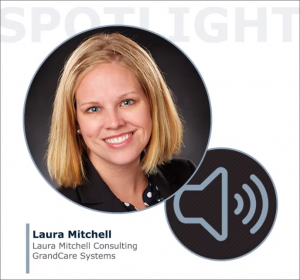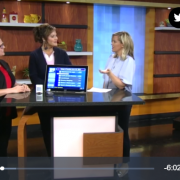A recent May 1 article in Health Data Management “High Tech = High Touch”, authored by Elizabeth Gardner, discusses the importance of technology for the senior population throughout the continuum of care and to help mitigate hospital readmissions.
She uses a few flagship technologies to exemplify how information technologies are helping individuals to stay healthy.
In a section titled “GRANDCARE: STAYING CONNECTED AT HOME“, Gardner interviews Evergreen, a Silicon Valley-based Long Term Care Provider utilizing the GrandCare solution, GrandCare’s VP of Business Development, Laura Mitchell and GrandCare’s Chief Medical Officer, Dr. Erick Eiting.
…
Excerpt of the article:
A profusion of technologies can help people stay in their homes as they age, despite physical and mental disabilities: monitors and sensors to track vital signs and movement, the Internet for communication and entertainment, smart home features to control lights and temperature. However, tying them all together is a challenge beyond most elderly people and even the younger family members who may be caring for them.
That’s where GrandCare Systems, West Bend, Wisc., comes in. Started nine years ago, its goal is “to keep individuals safe, happy and independent at home, whatever that means,” says Laura Mitchell, vice president of business development.
. ..
..
“I have a 95-year-old resident who reads bedtime stories every night to her great grandchild in Florida,” he says. “She just has to press the button with his picture and they’re connected. No turning anything on, logging in or memorizing phone numbers.”
…
GrandCare Chief Medical Officer Erick Eiting, M.D., who’s also assistant professor of emergency medicine at the University of Southern California, thinks the system’s monitoring capabilities will be invaluable for improving communication between patients and their medical team.
“We can look at whether you’re taking your meds when you should be, and if not, why not,” he says. Problems with side effects can be headed off without requiring an office visit.
“We had one CHF patient who thought he was taking his meds, but we could see he wasn’t taking the evening dose of his diuretic,” Eiting says. “When we asked him why, he said it made him have to get up and go to the bathroom during the night. We increased his morning dose and that fixed it.”
…
Click here to view the entire article
 GrandCare has been making the news!
GrandCare has been making the news!

 ..
..




 “PREDICTION – mHEALTH REVIVES MONITORING: The stationary nature of in-home activity and telehealth monitoring will give way to a disconnect-and-go tablet world that can be docked at home and plays nicely with a cell/smart cellular model. For those walking the floors at CES, you will see tablet apps of every type flowering hither and yon – perhaps you’ll see them tether to a phone. RIM, the anti-marketer, produced an early version of this with the Playbook-BlackBerry tethering. Why not a few tablet apps for seniors (in addition to health and activity monitoring) that sync up with a phone-like device? It may be like trying to cram a large box into a flat rectangle, to start at the hardware end — look at Care Innovations Guide, for example. Why not a partnership between a fitness device vendor (like Fitbit or Philips DirectLife) and a remote monitoring vendor like BeClose or Healthsense? And software-only products like Independa and GrandCare may well benefit from both platform flexibility and a new interest in combining activity sensors and health monitoring.”
“PREDICTION – mHEALTH REVIVES MONITORING: The stationary nature of in-home activity and telehealth monitoring will give way to a disconnect-and-go tablet world that can be docked at home and plays nicely with a cell/smart cellular model. For those walking the floors at CES, you will see tablet apps of every type flowering hither and yon – perhaps you’ll see them tether to a phone. RIM, the anti-marketer, produced an early version of this with the Playbook-BlackBerry tethering. Why not a few tablet apps for seniors (in addition to health and activity monitoring) that sync up with a phone-like device? It may be like trying to cram a large box into a flat rectangle, to start at the hardware end — look at Care Innovations Guide, for example. Why not a partnership between a fitness device vendor (like Fitbit or Philips DirectLife) and a remote monitoring vendor like BeClose or Healthsense? And software-only products like Independa and GrandCare may well benefit from both platform flexibility and a new interest in combining activity sensors and health monitoring.”
